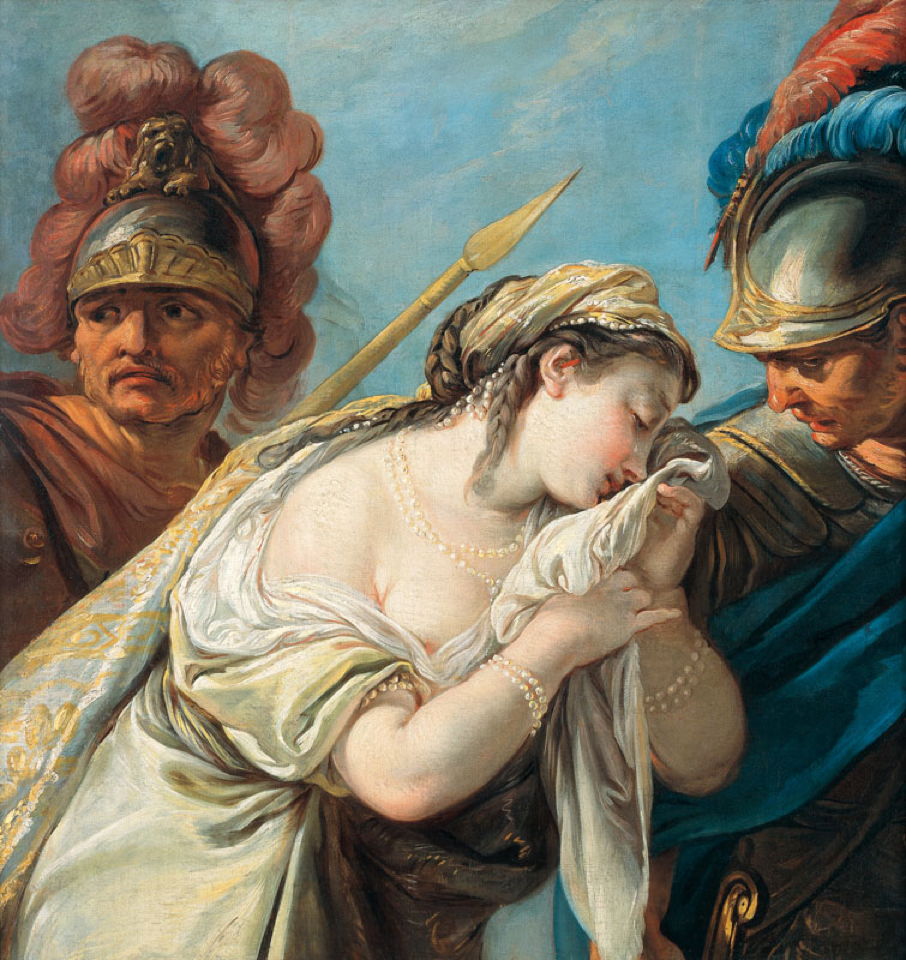Heroines: Introduction, overview and contents

Ovid’s Heroines (Heroides in the original Latin) are among his more controversial writings. They could have been written early in his career, or quite late, and some have claimed that few of its letters were even written by him. Until the late nineteenth century, they were among his most popular works, at times better-known than his Metamorphoses. Bizarrely, it was after the critical attention they received during the nineteenth century that they started to decline in popularity.
Heroines consist of two series of letters, and Ovid claimed that they established a new genre of epistolary (poetic) fiction. The genre has developed considerably since, although it remains limited in scope and popularity.
The first series, consisting of letters 1 to 15, are fictional letters written by a woman, one of Ovid’s heroines, to her partner during a time of separation. Their situations vary considerably, from Penelope’s imminent reunion with her husband after twenty years apart, to several who knew that they could never be reunited and chose suicide.
The second series, letters 16 to 21, consists of three pairs of fictional letters, the first from the man to the woman, and the second from the woman to the man, in relationships where Ovid considers the woman to have been a heroine. They’re accounts of famous couples, whose lives weren’t necessarily ended because of their relationship. Indeed, the collection ends with the thoroughly positive story of Cydippe and Acontius, who seem to have lived happily thereafter.
The most recent literary critical examinations of Ovid’s letters consider them to have been highly innovative in their approach to gender and its roles. For a male Augustan poet to have even considered writing such a collection seems extraordinary. When you read the individual letters, many have deep insight, and a timelessness that’s exceptional among contemporary literature.
These Heroines have inspired many fine paintings and other works of art over the centuries, many of which share Ovid’s radical ideas on women and their roles. I hope that this series of articles reflects those paintings, and does justice to Ovid’s poetic epistles.
References
Wikipedia.
AS Kline’s translation.
The Latin Library‘s text in Latin.
Downloadable PDFs of Loeb Classical Library – L041 includes the Heroides in English and Latin.
Arthur Palmer’s edition and commentary (1898).
Murgatroyd, Paul, Reeves, Bridget, & Parker, Sarah (2017) Ovid’s Heroides, a New Translation and Critical Essays, Routledge. ISBN 978 1 138 72216 3. (Essential and comprehensive.)
Boyd, Barbara W (ed) (2002) Brill’s Companion to Ovid, Brill. ISBN 978 90 04 22676 0.
Hardie, Philip (2002) The Cambridge Companion to Ovid, Cambridge UP. ISBN 978 0 521 77528 1.
Knox, Peter E (ed) (2009, 2013) A Companion to Ovid, Wiley-Blackwell. ISBN 978 1 118 45134 2.
Syme, Sir Ronald (1978) History in Ovid, Oxford UP. ISBN 019 814825 9.
Kenney, EJ (1996) Ovid Heroides, XVI-XXI, Cambridge UP. ISBN 978 0 521 46623 3.
Knox, Peter E (1995) Ovid Heroides, Select Epistles, Cambridge UP. ISBN 978 0 521 36834 6.
Palmer, A (ed) (1898, 2005) Ovid Heroides, vol 1, Latin text, Bristol Phoenix Press. ISBN 978 1 904675 05 0.
Palmer, A (ed) (1898, 2005) Ovid Heroides, vol 2, Commentary, Bristol Phoenix Press. ISBN 978 1 904675 06 8.
Gantz, Timothy (1993) Early Greek Myth, A Guide to Literary and Artistic Sources, vol 1, Johns Hopkins UP. ISBN 978 0 801 85360 9.
Gantz, Timothy (1993) Early Greek Myth, A Guide to Literary and Artistic Sources, vol 2, Johns Hopkins UP. ISBN 978 0 801 85362 3.
Morford, MPO, Lenardon, RJ, & Sham, M (2015) Classical Mythology, 10th ed., Oxford UP. ISBN 978 0 19 999739 8.
1: Penelope to Ulysses, Penelope in Ithaca
She waited patiently and faithfully for his return from the war against Troy.
Dante Gabriel Rossetti (1828–1882), Penelope (1869), chalk, primarily red, 90.2 × 71.1 cm, Private collection. Wikimedia Commons.
2: Phyllis to Demophoon, Abandonment, suicide and scandal
She fell in love with him as he was returning from Troy, but they couldn’t marry at the time, and he later abandoned her.
Edward Burne-Jones (1833–1898), Phyllis and Demophoon (1870), bodycolour and watercolour with gold medium and gum arabic on composite layers of paper on canvas, 47.5 x 93.8 cm, Birmingham Museum and Art Gallery, Birmingham, England. Wikimedia Commons.
3: Briseis to Achilles, The anger of Achilles and the faithfulness of Briseis
Taken as a concubine after her family had been killed, she remained faithful to Achilles when taken by Agamemnon.
Jean-Baptiste-Henri Deshays (1729–1765), Briseis Led from the Tent of Achilles (c 1761), oil on canvas, 83 x 78.5 cm, Musée des Augustins de Toulouse, Toulouse, France. Wikimedia Commons.
4: Phaedra to Hippolytus, Phaedra’s shame and a chariot accident
A stepmother who fell in love with her stepson.
Alexandre Cabanel (1823–1889), Phaedra (1880), oil on canvas, 194 x 286 cm, Musée Fabre, Montpellier, France. Wikimedia Commons.
5: Oenone to Paris, Paris’s jilted lover
Paris’s first wife, whom he abandoned when he abducted Helen to Troy.
Jacob de Wit (1695–1754), Paris and Oenone (1737), oil on canvas, 99.5 x 146.5 cm, Rijksmuseum Amsterdam, Amsterdam. Wikimedia Commons.
6: Hypsipyle to Jason, Jason’s first abandoned wife
A queen he married then abandoned on his way to Colchis and the prize of the Golden Fleece.
Johann Christian Reinhart (1761-1847), Classic landscape with Hypsipyle and Opheltes (1816), oil, dimensions not known, Staatliche Kunsthalle Karlsruhe, Karlsruhe, Germany. Wikimedia Commons.
7: Dido to Aeneas, Dido’s doomed affair
Widowed Queen of Carthage who wanted him to stay when he sailed off to found the precursor to Rome.
Henry Fuseli (1741–1825), Dido (1781), oil on canvas, 244.3 x 183.4 cm, Yale Center for British Art, New Haven, CT. Wikimedia Commons.
8: Hermione to Orestes, The Plight of Hermione
First agreed to marry Orestes, but forced to marry Pyrrhus instead, and a rival of Andromache.
Anne-Louis Girodet de Roucy-Trioson (1767-1824), The Meeting of Orestes and Hermione (c 1800), pen and brown and black ink, point of brush and brown and gray wash, with black chalk and graphite, heightened with white gouache on cream wove paper, 28.5 x 21.8 cm, Cleveland Museum of Art (Leonard C. Hanna, Jr. Fund), Cleveland, OH. Courtesy of Cleveland Museum of Art.
9: Deianira to Hercules, Blood of a centaur and the troubled woman
Married to Hercules, when he left her for Iole, she sent him a tunic impregnated with toxic blood from the centaur Nessus.
Evelyn De Morgan (1855–1919), Deianira (c 1878), oil on canvas, dimensions not known, Private collection. Wikimedia Commons.
10: Ariadne to Theseus, Ariadne’s revenge
She helped him kill the minotaur, then eloped with him to Naxos, where he abandoned her.
Paulus Bor (circa 1601–1669), Ariadne (1630-35), oil on canvas, 149 x 106 cm, Muzeum Narodowe w Poznaniu, Poznań, Poland. Wikimedia Commons.
11: Canace to Macareus, Canace and Laodamia in secret
Pregnant from her incestuous relationship with her brother.
Artist not known, Canace, from Heroines of Tor Marancia (date not known), fresco, dimensions not known, Sala delle Nozze Aldobrandine, The Vatican.
12: Medea to Jason, The many faces of Medea
Sorceress who ensured Jason won the Golden Fleece, but later abandoned, so she killed Jason’s next wife and her own two children.
Frederick Sandys (1829–1904), Medea (1866-68), oil on wood panel with gilded background, 61.2 x 45.6 cm, Birmingham Museum and Art Gallery, Birmingham, England. Wikimedia Commons.
13: Laodamia to Protesilaus, Canace and Laodamia in secret
Widow of the first Greek to land and engage the Trojans at the start of the war.
George William Joy (1844-1925), Laodamia (1878), oil on canvas, 107.3 x 153.3 cm, Portsmouth City Museum, Portsmouth, England. The Athenaeum.
14: Hypermnestra to Lynceus, The crime of faithfulness
Refused to kill her newlywed husband.
John William Waterhouse (1849–1917), The Danaides (1903), oil on canvas, 111 × 154.3 cm, Private collection. Wikimedia Commons.
15: Sappho to Phaon, Sappho and the ferryman
A well-known Lesbian who is claimed to have ended her life for the love of a ferryman.
Simeon Solomon (1840–1905), Sappho and Erinna in a Garden at Mytilene (1864), watercolour on paper, 33 x 38.1 cm, The Tate Gallery (Purchased 1980), London. © The Tate Gallery and Photographic Rights © Tate (2016), CC-BY-NC-ND 3.0 (Unported), http://www.tate.org.uk/art/artworks/solomon-sappho-and-erinna-in-a-garden-at-mytilene-t03063
16, 17: Paris to Helen, Helen to Paris, Helen of Troy: victim or villain? part 1 and part 2
Abducted or seduced by the Prince of Troy, she later helped the Greek forces take the city.
Gaston Bussière (1862–1928), Helen of Troy (1895), oil on canvas, dimensions not known, Musée des Ursulines de Mâcon, Mâcon, France. Image by Vassil, via Wikimedia Commons.
18, 19: Leander to Hero, Hero to Leander, Paintings of Forbidden Love: Hero and Leander
He swam the Hellespont to meet his lover, until one night it went wrong, he drowned and she killed herself.
Frederic Leighton, 1st Baron Leighton (1830–1896), Last Watch of Hero (1880), further details not known. Wikimedia Commons.
20, 21: Acontius to Cydippe, Cydippe to Acontius, Cydippe’s apple of love
He tricked her into vowing to marry him using an apple bearing an inscription.
Paulus Bor (c 1601–1669), Cydippe with Acontius’s Apple (date not known), oil on canvas, 151 x 113.5 cm, Rijksmuseum Amsterdam, Amsterdam. Wikimedia Commons.




